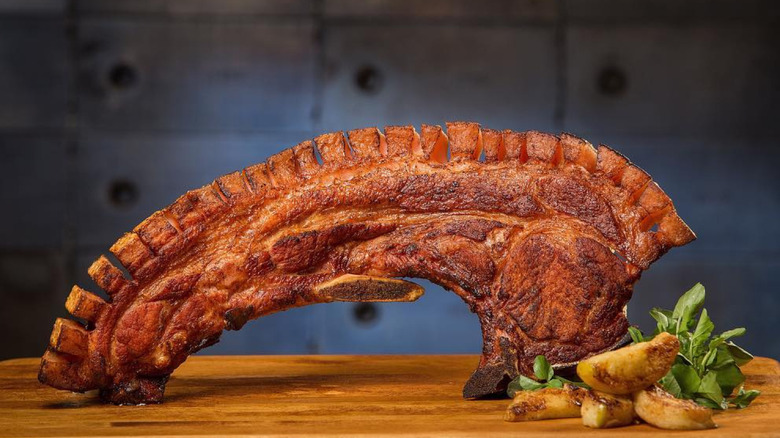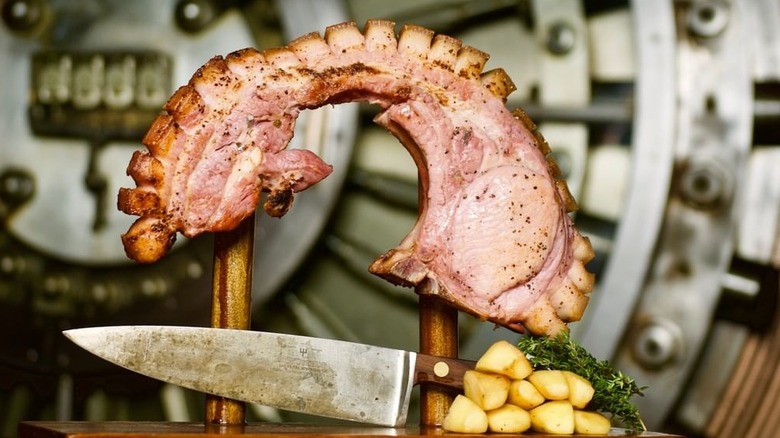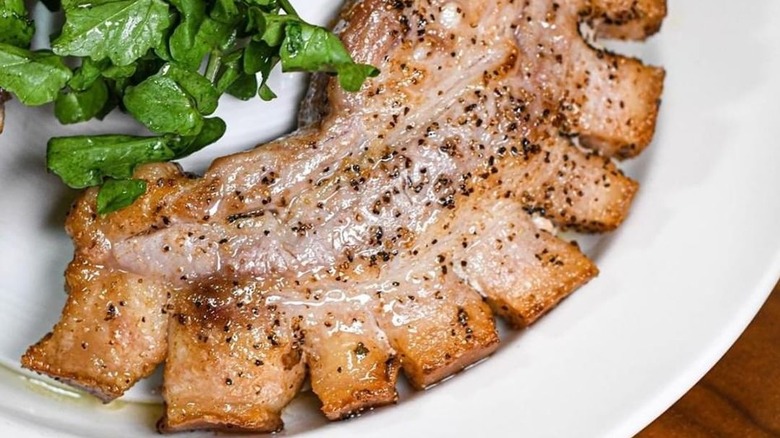The Kan-Kan: A Meat Mohawk Of The Highest Caliber
Picture a mohawk made of meat — a giant, arched slab of bone and flesh, studded with crispy sections of fat that have been splayed out in cubes to create almost a spiky effect along the top. It's like a massive hunk of pork turned into a punk rocker. That's what kan-kan looks like.
Some call it a pork tomahawk, others a saddleback chop. Many know it as chuleta kan-kan, which simply means can-can pork chop. Whatever you call it, this is one incredible (and unique) pork chop — though it isn't alone in the category (hello, pork chop-stuffed French toast). Its unfamiliar name, kan-kan (or sometimes can-can), supposedly comes from the fried chicharrones (the crispy pork skin that lines the top of the semicircle) because they look like the ruffled bottom of a can-can dancer's skirt.
This colossal cut of meat is essentially a cross-section of several different parts of the pig: rib, loin, belly, and fatty skin. The entire rib bone is attached to the loin, which continues to fan out to include an outer layer of fat and skin that encase the entire chop. It's just as impressive to look at as it is to eat.
The 4-1-1 on kan-kan
So where did kan-kan come from? It's a unique style of pork chop believed to have originated in San Juan, Puerto Rico. Many give credit to a restaurant called La Guardarraya for serving it for the first time in the late 1950s. Since then, others have adopted their own versions of the dish in different shapes and sizes, but it's still fairly obscure today.
Especially in America, kan-kan isn't necessarily easy to find. This cut of meat isn't exactly something you can just pick up from your local butcher, neither is kan-kan something you'll see listed on many steakhouse menus. It's not only hard to find but hard to even describe. So if you come across one, don't miss your chance to try the behemoth double-loin, bone-in-pork-chop creation that's encircled in fatty goodness.
You'll no doubt be wowed by its sheer size and distinct look, but also by its multifaceted taste. Because there are so many different parts of the pig included in one cut, kan-kan is an exceptionally flavorful piece of meat, with several different tastes and textures on one plate.
How to prepare and cook kan-kan pork
The traditional way to make kan-kan pork is to deep-fry the pork chops. Unfortunately, pork is notorious for being hard to cook as it dries out so quickly. Add in different cuts cooking at one time, and it gets even trickier. When Guy Fieri visited a Puerto Rican restaurant to make Chuleta Kan-Kan on an episode of "Diners, Drive-Ins, and Dives," he explained that the challenge in cooking a cut of meat like this is to get the ribs and sides tender without drying out the loin areas.
That's why, as far as preparation, brining is key. After brining the pork in salt or baking soda and water overnight, rinse the brine off and rub the meat with a seasoning blend of aromatics, spices, and oil. It's often baked or roasted first, and then deep fried to a deliciously deep golden brown.
But the chicharrones — aka the cubed stubs of crispy pork belly and skin that line the outside of the chop — are the most important part of the cooking process because this is what creates the "mohawk" that sets this dish apart. To create even cuts that give the outside of the chop the ultimate crunch and crispiness, you need to slice the outer layer of fat into one to one and a half inch squares. Make sure to only cut the fat and not the muscle!



